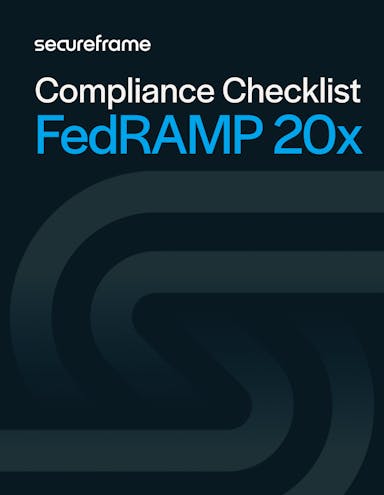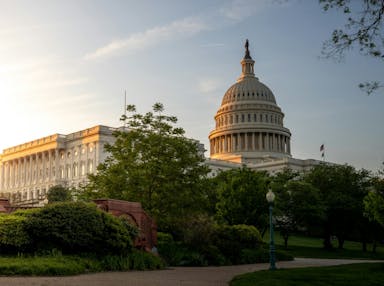
When Worlds Collide: A FedRAMP Auditor Turned Compliance Automation Practitioner’s First-Hand Take on FedRAMP 20x’s Shift to Automation
Rob Gutierrez
Senior Cybersecurity and Compliance Manager, CISA, CCSK, CMMC RP
Emily Bonnie
Senior Content Marketing Manager
Earlier this week, the federal government announced FedRAMP 20x, a significant overhaul of the Federal Risk and Authorization Management Program. This marks a major shift in federal cloud compliance, one that will fundamentally change how cloud service providers work with federal agencies.
When FedRAMP was first introduced, its goal was to modernize and streamline federal cloud security by creating a standardized approach that would improve national security while reducing process and technological inefficiencies. Yet over time, excessive red tape, high costs, incredibly long wait and authorization times, and administrative burdens created high barriers to entry and made compliance accessible only to large enterprises with large budgets and stand alone GRC teams.
If you look at the FedRAMP marketplace today, roughly 98% of the 386 authorized providers are massive enterprises with dedicated governance, risk, and compliance teams solely focused on FedRAMP readiness and compliance. Smaller, security-conscious cloud companies with innovative solutions have largely been shut out — not because they lack strong security controls or don’t want to get FedRAMP compliant, but because of the sheer time and resources needed to navigate the authorization process.
As a former FedRAMP auditor who has spent the last three years working in compliance automation, I see these changes as long overdue. I meet with customers all of the time who want to work with and support the government, have federal agencies that want to work with them, and have great technology that could help our country, but once I tell them the level of effort and costs associated with a FedRAMP authorization they quickly realize it does not make sense for their business. By focusing on efficiency, embracing automation, and reducing unnecessary bureaucratic layers, the government is finally making FedRAMP more accessible for all cloud service providers (CSPs) and innovators.
This isn’t just good news for cloud service providers. It’s a win for federal agencies that need faster access to secure, innovative cloud technologies, and for the American people who will ultimately benefit from a more agile, efficient, and modernized federal IT landscape.
Recommended reading

FedRAMP 20x: Here’s What We Know About the Transformation of FedRAMP & Timeline
FedRAMP 20x and the push for efficiency
FedRAMP 20x introduces major changes aimed at improving efficiency and eliminating redundancy in the current authorization process. The move toward automation, self-attestation, and closer alignment with widely accepted industry certifications reflects a broader government push for modernization and efficiency.
The most significant change comes from eliminating red tape and bureaucratic bottlenecks that have historically slowed down the authorization process, including redundant documentation and prolonged third-party assessments. By removing mandatory 3PAO audits for low-impact systems, while leveraging compliance automation software and technology, FedRAMP 20x will significantly reduce the time and expense required for authorization.
At the same time, the program places compliance automation at the center of the process, shifting CSPs away from point-in-time assessments and toward real-time security monitoring and continuous compliance. By leveraging compliance automation, agencies and CSPs can continuously validate their security posture and verify compliance, while also improving transparency with agencies through real-time dashboards that offer instant visibility into compliance and control status. This streamlined approach reduces manual effort, eliminates redundant documentation, makes it easier to stay up to date with the latest standards, and accelerates the authorization process, allowing more CSPs to enter the federal market while maintaining strong security standards.
The remaining challenges of FedRAMP 20x
Like many things involving change in life, there are trade-offs to consider. So while these updates introduce long-overdue improvements, they also raise important questions about security rigor and the potential introduction of risk — particularly in transferring the burden of responsibility from auditors to CSPs and determining if this will have any effect on federal data. While greater accessibility is a win, security standards can’t be compromised in the name of efficiency.
If not properly structured and enforced, self-attestations could open the door to inconsistencies in how security controls are implemented and validated. Agencies must be prepared to hold CSPs accountable through real-time oversight and strict enforcement of continuous monitoring requirements to prevent potential security gaps.
To ensure both strong security and standardized compliance standards, FedRAMP working groups and pilot programs must come to unanimous, well-defined decisions on what is expected and required for compliance. This is critical not only for maintaining strong security configurations and controls, but also for ensuring efficiency and technical uniformity within the industry. Without this level of consensus, inconsistencies in interpretation and implementation could lead to fragmented security postures across CSPs, creating vulnerabilities within government IT systems and ultimately national security. These working groups have an important opportunity, and frankly important responsibility as well, to establish clear, enforceable guidelines that promote robust security in cohesion with a streamlined, standardized compliance process.

FedRAMP 20x Low Compliance Checklist
Participants in the FedRAMP 20x Phase One pilot seeking FedRAMP Low authorization must apply all Key Security Indicators (KSIs) to all aspects of their cloud service offering. Use this checklist listing all KSIs and their underlying NIST 800-53 controls to evaluate your compliance status.
Previously, FedRAMP compliance emphasized annual 3PAO audits, where CSPs could prepare extensively in advance and treat authorization as a set milestone rather than an ongoing effort. While continuous monitoring has always been a requirement, the audit process has played a much larger role in validating compliance. Now, with the move to self-attestation and increased reliance on automation, the focus is on real-time security monitoring and proactive risk management. Instead of an audit-driven compliance cycle, CSPs will need to ensure continuous validation and real-time reporting of security controls to maintain authorization.
This is much more than a procedural change; it’s a fundamental shift in mindset. Compliance must become an ongoing function that’s fully integrated into the CSP’s daily security and business operations. Success under FedRAMP 20x will not only require CSPs to implement a compliance automation tool, but also align on cybersecurity best practices and ensure the automation platform’s integrations and functionality supports those best practices. Ensuring standardized and strong security and configuration settings while also ensuring efficiency and technical uniformity within the community & industry and ultimately government will be critical to ensuring the success of FedRAMP 20x in the future. CSPs that embrace automation early will be in a better position to adapt quickly when official automation requirements are finalized.
CSPs that already comply with industry best practices like SOC 2, ISO 27001, and NIST 800-53 will also experience a smoother transition. These companies have already embedded strong security controls and risk management practices into their operations, which means they’re already well aligned with the new compliance structure. For CSPs that haven’t yet adopted these frameworks, now is the time to start — not only to prepare for FedRAMP 20x, but to ensure a stronger overall security posture that meets customer expectations and protects against data risks.
Another major question is the evolving role of 3PAOs. While they may not be required for low-impact systems, they will likely remain integral for moderate- and high-impact authorizations. As a former employee of a 3PAO, I’ve seen firsthand the immense industry knowledge and expertise these assessors bring. I hope they will continue to play an important role in shaping FedRAMP’s next stage of evolution, whether through industry working groups, pilot programs, and/or assessments for more sensitive systems.
Recommended reading

Navigating FedRAMP 20x: What The Changes Mean For Federal CSPs & How To Prepare
How FedRAMP 20x will impact CSPs that are authorized or seeking authorization
The upcoming transition to FedRAMP 20x will have significant implications for CSPs at every stage of the compliance journey, whether they’re already FedRAMP Authorized, currently seeking authorization, or just starting the process.
For CSPs that have already achieved FedRAMP authorization, these changes should simplify continuous monitoring efforts and significantly reduce the costs of maintaining authorization. The previous FedRAMP model required extensive recurring assessments that added to the long-term burden of compliance. Under FedRAMP 20x, maintaining authorization should become more efficient and cost-effective.
For companies currently working toward FedRAMP authorization, the best approach is to stay the course while keeping a close eye on future developments. The fundamentals of FedRAMP security requirements should remain the same, but organizations should begin thinking about how they will transition to a continuous compliance model and automation platform once FedRAMP 20x is fully implemented.
A platform like Secureframe can help CSPs track their compliance posture against FedRAMP requirements, maintain security controls more efficiently, and ensure preparation and readiness for a future of continuous monitoring. Moving compliance out of static documents like spreadsheets and into a real-time automation tool will help CSPs stay ahead as the new FedRAMP model takes shape.
For companies just beginning their FedRAMP compliance journey, the most important starting point is building a strong System Security Plan (SSP). This document is the foundation for FedRAMP compliance, detailing how your organization meets security requirements and outlining the controls you’ve put in place to protect federal data and meet requirements.
The SSP is often the most time-intensive and resource-heavy part of the compliance process, requiring detailed documentation and a deep understanding of FedRAMP’s security requirements. Compliance automation tools like Secureframe can significantly ease this burden by providing pre-mapped requirements, control monitoring, and automated evidence collection. Investing in an automation platform early will not only accelerate the authorization process, but also set up CSPs for long-term compliance success under FedRAMP 20x.
The broader implications of FedRAMP 20x and the future of federal compliance
For too long, federal IT compliance has lagged behind the private sector, weighed down by outdated and inefficient processes and archaic systems. The Department of Defense, despite the largest defense budget in the world, has failed its audit and been out of compliance for seven consecutive years — a clear example of systemic inefficiencies.
But with strong federal initiatives around automation, AI, and modernization, compliance could finally become a global model for balancing security with agility and efficiency. The US already leads in compliance automation technology, with companies like Secureframe setting the standard. With FedRAMP 20x, we have an opportunity to leverage cutting-edge technology to create compliance processes that are not only more efficient, but also more secure. Now, it’s up to CSPs, federal agencies, and compliance leaders to work together, march forward, and ensure that FedRAMP 20x delivers on its promise. After all, as Steve Jobs famously said, “Innovation is the ability to see change as an opportunity, not a threat.”
The intersection of federal compliance and automation is an exciting and promising shift that benefits the entire federal ecosystem. Those who embrace this change will not only stay ahead in compliance, but also help shape the future of cloud adoption for the federal government.
Recommended reading

Why Compliance Automation is a Strategic Advantage for Modern Organizations

Rob Gutierrez
Senior Cybersecurity and Compliance Manager, CISA, CCSK, CMMC RP
Rob Gutierrez is an information security leader with nearly a decade of experience in GRC, IT audit, cybersecurity, FedRAMP, cloud, and supply chain assessments. As a former auditor and security consultant, Rob performed and managed CMMC, FedRAMP, FISMA, and other security and regulatory audits. At Secureframe, he’s helped hundreds of customers achieve compliance with federal and commercial frameworks, including NIST 800-171, NIST 800-53, FedRAMP, CMMC, SOC 2, and ISO 27001.

Emily Bonnie
Senior Content Marketing Manager
Emily Bonnie is a seasoned digital marketing strategist with over ten years of experience creating content that attracts, engages, and converts for leading SaaS companies. At Secureframe, she helps demystify complex governance, risk, and compliance (GRC) topics, turning technical frameworks and regulations into accessible, actionable guidance. Her work aims to empower organizations of all sizes to strengthen their security posture, streamline compliance, and build lasting trust with customers.